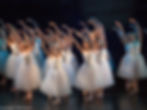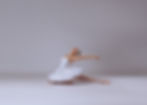Costuming Swan Lake
- Cindy Case
- Apr 21
- 4 min read
Updated: Jun 30

Swan Lake is almost here! As rehearsals of the ballet shifted into full run-throughs of the production, our wardrobe team has been hard at work pulling Swan Lake's costumes together.
Costumes are vital in many ways: for creating a mood, demonstrating character, and building a visually appealing aesthetic. With the help of our costume team and dancer volunteers, Wardrobe Coordinators Karissa Kralik and Clara Molina have risen to this challenge. Like ballet itself, costuming a production is a team effort that requires handling a lot of moving parts! Read on for a few important parts of the process.

White Swan / Black Swan
Building a tutu is labor-intensive, representing a significant use of time and resources. Karen Kralik, who lives out of state, constructed the individual pieces for these tutus and shipped them to BTM.

Each of these pieces--bodice, basque, and tutu--were then fit onto their corresponding dancer. Karissa, balancing the dual role of Odette/Odile and Wardrobe Coordinator, added a fabric overlay to the tutus and began sewing the pieces together.

At this point, the tutus were ready for Clara and Karissa to decorate them. As you can see above, the two costumes are photo negatives of each other. Although Odette wears white with silver trim and Odile wears black with gold, the two costumes otherwise match down to the individual embellishments. This helps create the onstage illusion for Siegfried that Odile is Odette.

An Army of Swans
In addition to the four platter tutus for Odette and Odile (both of our lead dancers have their own tutus for both roles), there's also an entire corps de ballet of swans to dress in romantic tutus. There are 24 swans onstage in a given performance, but the costume team has prepared 32 brand-new swan costumes.
Some of the roles are played by different dancers between shows, so having this many costumes allows each dancer to have a costume that is a perfect fit. When we have back-to-back performances, the dancers also appreciate getting to put on a costume that wasn't just worn!

Court Fashions
There's a big emphasis on swans, but not all of the characters in Swan Lake are birds. Also important are the costumes worn in the court scenes of the ballet.

Central among them, Prince Siegfried's costumes are a good example of how costuming helps to tell the story. The deep blue he wears when the show opens helps him fit in with the stronger blues and golds of his court, but it is far better suited to the muted color palette of the lakeside ballet blanc scene that follows. In this way, we see that Siegfried belongs with Odette.

In the ballroom scene, Siegfried wears black accented with gold. The obvious reason for this is to match Odile's tutu, but the viewer can also infer something about Siegfried's state of mind. His mother has foisted this pageantry on him for his birthday, and Siegfried seems entirely disinterested. Is his dressing in black a form of silent protest?

Once Siegfried realizes he has made a vow to the wrong swan, he rushes back to the lake to beg for Odette's forgiveness. His black tunic amid the white swans is the only costuming change from the earlier white act, and this detail communicates how the story's mood has changed from hope to fear.

Eligible Princesses
Another example of how costumes can help tell the story is in the dresses worn by the princesses at the royal ball. Each princess represents a different nation, so they each require a distinctive look. At the same time, the costume team needed to create a cohesive visual for when the princesses dance together with Prince Siegfried.

Although Siegfried is occupied with the imposter Odile, the princesses perform their prepared dances for the court anyway. We begin with the Hungarian princess, who dances a Czárdás with two gentlemen. This Hungarian folk dance starts slowly, matching the elegance of her red and cream costume, but gradually builds tension until it bursts into a fast pace.
Next, the Russian princess shares the stage with her four female attendants. Karissa describes her costume as having "Guinevere sleeves," due to the medieval inspiration of the long, drapey tippets.

The Spanish princess dances with a fan and is backed up by two male dancers. The purple fringe and other Spanish touches in her costume may remind you of Don Quixote or the Spanish divertissements in The Nutcracker.
The Neapolitan princess, with short, puffy sleeves and a yellow overlay on her skirt, harkens back to our performances of Napoli earlier this season. She and her two attendants keep the rhythm as they dance with tambourines.

Lastly, the Polish princess performs a mazurka with a male partner and four ladies. This stylized dance form is based on Polish folk dances and is a common feature in other ballets such as Coppelia and Sleeping Beauty.
These costumes represent a small fraction of the ones you'll see onstage at Swan Lake this weekend! Keep your eyes peeled on Instagram and Facebook for more costumes, and visit our ticket page to reserve your seats for our performances on Friday, April 25, and Saturday, April 26.

Promotional photo by Joanne Salyer
Costume photos by Cindy Case
